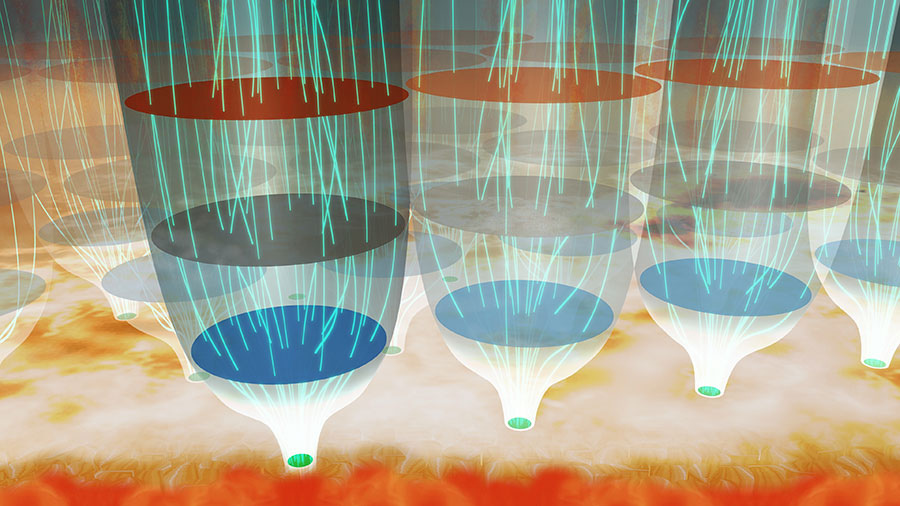2020/12/21 アメリカ合衆国・ローレンスバークレー国立研究所(LBNL)

・ LLNL が、アルコールから水素を抽出する、優れた選択性、生産性と安定した性能のニッケル(Ni)ナノクラスターと窒化ホウ素(BN)の 2D 基板による触媒を開発。
・ 液体のケミカルキャリアから水素原子を除去する反応をクリーンかつ効率的に促進する同触媒は、従来使用される貴金属に代わり安価で豊富な金属から構成され、様々なアプリケーションのエネルギー源としての水素利用の実現を助ける。
・ 水素は、輸送、発電や金属工業等多様な経済部門に付加価値を提供する、有害物質排出のないクリーンエネルギー資源。持続可能なエネルギー生産と燃料利用を橋渡しする水素の貯蔵・輸送技術は、水素経済の実現において不可欠な要素だが、従来の貯蔵・輸送方法は高コストでコンタミネーションの恐れがあるため、低コストでシンプルな安定した代替技術が求められる。
・ 液体のキャリアからの水素抽出には、貴金属の触媒が最も効果的ではあるが、コスト、希少性やコンタミネーションの問題がある。一般的な金属の触媒は、効果や安定性に劣るため、水素生産産業での実用には限りがある。
・ 今回開発した触媒は、高活性の達成だけでなく、様々な反応に手頃な金属を利用するための幅広い戦略を示すもの。本研究は、米国エネルギー省(DOE)のエネルギー効率・再生可能エネルギー局(EERE) 、水素・燃料電池技術室が資金を提供する Hydrogen Materials Advanced Research Consortium(HyMARC)の一環。
・ ナノクラスターは材料の反応表面を最大限に露出させるが、凝集しやすいため反応性が抑制される。この問題を BN 基板に原子スケールのくぼみを作り、直径 1.5nm の Ni クラスターを積層することで解決。Ni クラスターはくぼみにて均一に分散・固定し、凝集を回避するだけでなく、Ni クラスターとの直接的な相互作用による熱・化学的特性が触媒の性能を飛躍的に向上させる。
・ また、同触媒の高性能がそのサイズに起因することを解明。露出した金属原子のナノクラスターは大きな金属粒子よりも液体キャリを引きつけやすく、クラスターの表面を詰まらせるコンタミネーションの形成を回避しながら、キャリアから水素を取り出す化学反応のステップを減少させる。BN 基板に欠陥を導入し、Ni クラスターの微細サイズを保つことで、これらの優れた触媒特性を達成した。
・ 今後は、金属ナノクラスターを担持する 2D 基板の改善をさらに進め、より効率的な触媒開発を目指す。
URL: https://newscenter.lbl.gov/2020/12/21/improved-hydrogen-fuel-production/
<NEDO海外技術情報より>
(関連情報)
米国科学アカデミー紀要(PNAS)掲載論文(アブストラクトのみ:全文)
Enhanced and stabilized hydrogen production from methanol by ultrasmall Ni nanoclusters
immobilized on defect-rich h-BN nanosheets
URL: https://www.pnas.org/content/117/47/29442
Abstract
Employing liquid organic hydrogen carriers (LOHCs) to transport hydrogen to where it can be utilized relies on methods of efficient chemical dehydrogenation to access this fuel. Therefore, developing effective strategies to optimize the catalytic performance of cheap transition metal-based catalysts in terms of activity and stability for dehydrogenation of LOHCs is a critical challenge. Here, we report the design and synthesis of ultrasmall nickel nanoclusters (∼1.5 nm) deposited on defect-rich boron nitride (BN) nanosheet (Ni/BN) catalysts with higher methanol dehydrogenation activity and selectivity, and greater stability than that of some other transition-metal based catalysts. The interface of the two-dimensional (2D) BN with the metal nanoparticles plays a strong role both in guiding the nucleation and growth of the catalytically active ultrasmall Ni nanoclusters, and further in stabilizing these nanoscale Ni catalysts against poisoning by interactions with the BN substrate. We provide detailed spectroscopy characterizations and density functional theory (DFT) calculations to reveal the origin of the high productivity, high selectivity, and high durability exhibited with the Ni/BN nanocatalyst and elucidate its correlation with nanocluster size and support–nanocluster interactions. This study provides insight into the role that the support material can have both regarding the size control of nanoclusters through immobilization during the nanocluster formation and also during the active catalytic process; this twofold set of insights is significant in advancing the understanding the bottom-up design of high-performance, durable catalytic systems for various catalysis needs.



